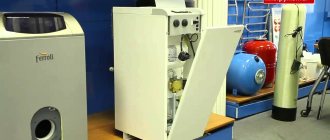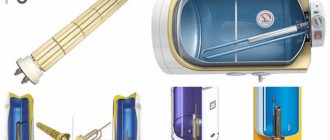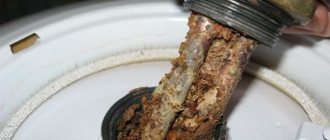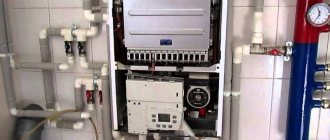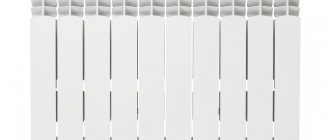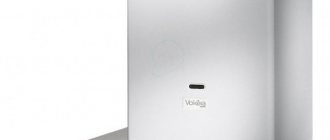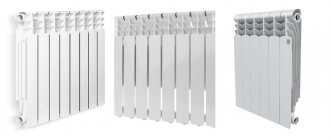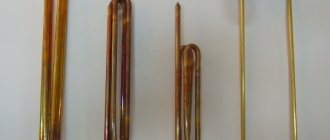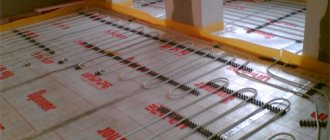Many people cannot imagine their life without hot water supply. But apartments do not always provide uninterrupted service to the population with these benefits. Private houses also need additional heating equipment. Therefore, the solution would be to purchase an electric storage water heater. For urban housing with a family of three people, a boiler with a tank volume of 50 to 100 liters is suitable. For country cottages, dachas, small cafes, you can take a 30-liter unit. But before you buy such a unit, you need to make sure that the design, characteristics, and capabilities of the water heater fully meet the buyer’s requirements.
Design Features
Cold water entering the storage water heater through specially supplied and connected channels is heated thanks to the heating element to the previously set temperature using temperature control.
Did you know that...
A dry heating element (tubular electric heater) for water heaters is a hollow tube hidden in a ceramic flask, surrounded by an anti-corrosion layer. Inside the tube there is a wire made of a special alloy. Thanks to the electric current supplied to the rod, the heating element heats up and gives off heat to objects around it. Between the wire and the tube there is quartz sand, which has dielectric properties, increasing the electrical safety of this equipment.
Typical breakdowns and their causes
Signs of a heating system malfunction are:
- long wait before turning on the heating element;
- a sharp increase in energy consumption;
- frequent operation of an RCD, which turns off the device when there is a current leak;
- too cold water (weak or insufficient heating);
- cyclic switching on and off of the heating element at a stable water temperature (for example, immediately after filling the tank full).
If the hot water is cloudy and has an unpleasant odor, this may be a sign of a clogged tank. In this case, some of the impurities are deposited on the heating tube, so the system needs to be completely disassembled and cleaned.
The reasons for the failure of the heating element can be:
- Short circuit of the element due to corrosion. To reduce the aggressive effect of water on the tube, a sacrificial electrode is installed next to it - an anode with a higher electrochemical potential. Due to the formation of a galvanic couple, the more active metal corrodes. When it corrodes, corrosion begins to affect the heating element.
- Disruption of heat transfer due to a layer of scale. Carbonate salts, which are contained in hard water, settle on the surface of the heating element. The presence of a magnesium or zinc electrode softens deposits, but does not stop the process of scale formation. If you neglect cleaning, the surface of the element will become covered with a thick enough layer of salts to disrupt the transfer of heat from the heating element to the water.
- Broken conductive thread inside the heater. Failure of the main element of the heating element can occur as a result of overheating, a power surge or a manufacturing defect.
The average service life of a part is 3-5 years.
Principle of operation
Dry heat boilers are in demand due to their functionality, as well as the speed of heating to the desired temperature. If the electric heater is not hidden in the shell, it comes into contact with hard water, and over time, limescale and scale will form on it. This increases the heating time. In a dry heating element, the rod is hidden, so scale does not hinder its operation.
The operating principle of the heating element located inside the tank:
- The valve opens and the tank is filled with water to a certain level.
- When the water is inside, the heating element turns on, bringing it to the temperature that is set in the installations.
- After heating, the heating element automatically turns off.
- When the water is not used immediately, the insulation around the tank keeps it hot.
Gorenje GBFU E B6 for 100, 80 and 50 liters
The water heater in question is designed for specific consumer needs. The volume of the water tank can be 50, 80 or 100 liters. Depending on this, the price of the device also changes. The boiler is connected to a 220 volt power supply and has a power of 2 kilowatts. To protect the product from the negative effects of corrosion, one magnesium anode is provided.
The advantages of Gorenje GBFU E B6 for 100, 80 and 50 liters are:
- small need for electricity to heat water;
- affordable price;
- ease of installation;
- reliability;
- fast heating of water (up to 3 hours after filling the entire volume with cold liquid).
The main disadvantage of this boiler is the error in the thermometer readings.
What is the difference between a wet heating element and a dry heating element - comparative characteristics
The biggest difference can be considered the design of both types of heating elements. The wet heater has a simple structure; it looks like a boiler - the element has the design of a large, hollow tube in which there is a nichrome spiral. Reaching the desired temperature occurs quickly, but the heating device is still new. The scale deposited on the pipe increases over time: the larger the layer, the more difficult it is for heat to break through and heat the water. Then there is only one way out - to change the wet heating element.
Do you know that…
A steatite heating element can also fail, but after a longer time. The service life of a wet heater is 2-3 years, and a dry heater is more than 5 years, which is economical in terms of replacing parts in the water heater.
The difference can also be considered the cost of equipment, which has different heating elements. Dry - costs more. It is considered more reliable and has higher heating properties. Also, one of the advantages of a dry heater over a wet one is that when replacing it, you do not need to drain the water, which is what you should do to repair the second option.
Advantages over traditional “wet” heating element
In terms of external features, the device in question is no different from a standard boiler. The same body, made in the form of a cylinder or parallelepiped, the presence of a temperature regulator and a thermometer with a scale. In modern models, the operation of the water heater can be monitored on a liquid crystal display.
Important: the main advantage of a water heater equipped with a dry heating element is a long period of operation, as well as the formation of a minimum amount of scale during operation.
If the heating elements in a conventional boiler are changed every two years, then dry heating elements are replaced with new ones every four years of operation . Despite the second advantage - a small layer of scale on the heated surface, the formation of this substance will depend on the quality of the water entering the container, as well as the operating temperature of the heater.
Types of heating elements in water heaters
Thus, conventional heating elements made from stainless steel or copper have a high temperature in small areas of the working surface, which will contribute to the accumulation of salts. Due to the formation of scale on the surface of the heating element, the water warms up worse, and heat transfer rates decrease. The accumulated sediment does not conduct heat well, which will ultimately contribute to the burnout of the coil and further replacement of the heating element.
The working surface area of a dry heater is much larger than that of its analogue, but it does not heat up as much, which can be achieved by adjusting the device. Lower water temperatures will help reduce the amount of deposited scale, which means our boiler will last longer without the need to replace the heating element. If a dry heating element burns out, it is much easier to replace it than a traditional one.
Please note: When replacing a dry heater, there is no need to drain the water heater. In this case, you just need to remove the heating element from the special flask and replace it with a new one.
Best models: top 9
Boiler models with dry heating elements are always popular due to their reliability and safety in operation. To choose a boiler for yourself, you need to take into account its cost and size - the water heater must fit well into the room where it will be installed. Many boilers have the ability to install them on the floor or hang them on the wall using special fasteners. The location can be different: horizontal or vertical. The stainless steel tank of such brands as Atlantica, Termex and Zanussi is their advantage, as it extends the life of the devices.
This rating was compiled based on recommendations from consumers who bought boilers from these brands and have been using them for a long time. They assessed the functionality of this water heating equipment and learned their advantages/disadvantages.
Boiler Fagor CB ECO
- Price - from 12,300 rubles.
- Volume – 150 l.
- Country of origin : Spain.
- White color
- Weight – 43 kg.
This European manufacturer opens the rating of dry water heaters, providing its products with the appropriate certificates in accordance with international standards. According to customer reviews, this boiler is reliable for a large family. The price is affordable to purchase it for almost any home.
Fagor CB ECO water heater
| pros | Minuses |
| Design | Poor mounting anchors |
| Heats up quickly | |
| Maintains temperature for a long time |
Gorenje OGBS100SMV9
- Price - from 10,100 rubles.
- Volume – 100 l.
- Country of origin : Serbia.
- White color
- Management is electronic.
- Weight – 41 kg.
The Gorenje electric heater is reliable and high-quality equipment that will last for many years. A convenient interface allows you to set the desired heating temperature. Added functions: power indicator, heating temperature limitation, 4 degrees of protection - allows you to feel the convenience of having such equipment in your home.
Gorenje OGBS100SMV9 water heater
| pros | Minuses |
| Heats water very quickly up to 70 degrees | Not very clear controls |
| Compact | |
| Good quality |
Atlantic Vertigo
- Price - from 17,200 rubles.
- Volume – 80 l.
- Country of origin : France.
- White color
- Management is electronic.
- Weight – 33 kg.
- Dimensions (WxHxD) – 49x109x31 cm.
Soapstone heating elements are a development of the Atlantic brand. French developers were looking for ways to improve the performance of the equipment, and the invention of such a heating element allows this water heater to be used for a long time.
Atlantic Vertigo water heater
| pros | Minuses |
| Good quality, design | Bad anchors |
| Heats up quickly | |
| Convenient control |
Electrolux EWH 50 Formax DL
- Price - from 10,799 rubles.
- Volume – 50 l.
- Country of origin : China.
- White color
- Management is electronic.
- Weight – 23.1 kg.
- Dimensions (WxHxD) – 34.4×82.5×35 cm.
Electrolux electric heaters are quite compact, quickly heat water, saving time and electricity.
Electrolux EWH 50 Formax DL water heater
| pros | Minuses |
| The flat shape of the Electrolux boiler saves space and looks good | No fasteners included |
| Good thermal insulation, loses less than 10 degrees of heat in 12 hours when turned off | |
| 3 heating modes |
Willer Elegance IVB DR
- Price - from 11,345 rubles.
- Volume – 80 l.
- Country of origin : China.
- White color
- Control is mechanical.
- Weight – 18 kg.
- Dimensions (WxHxD) – 49.3×99.2×29 cm.
A special feature of this unit is a fundamentally new tubular heating element system, which allows for rapid heating of water. A protective magnesium anode ensures the safety of the tank from corrosion and extends its service life. A good device for little money.
Willer Elegance IVB DR water heater
| pros | Minuses |
| The controls are very clear | There is no sound signal about the end of heating |
| Heats water in a few minutes | |
| Tank cover: stainless steel |
Atlantic Steatite Cube VM 75 S4 CM
- Price - from 13,990 rubles.
- Volume – 75 l.
- Country of origin : France.
- White color
- Control is mechanical.
- Weight – 27 kg.
- Dimensions (WxHxD) – 49×70.6×52.9 cm.
The French are very responsible in the production of various equipment and this water heater is no exception. European quality, reliability, stable operation of the boiler will please any buyer.
Atlantic Steatite Cube VM 75 S4 CM water heater
| pros | Minuses |
| Two operating modes (1.2 and 2.4 kW) | No built-in thermometer |
| Good thermal insulation | |
| Heats up quickly |
Ariston PRO ECO 50 V DRY HE
- Price - from 13,990 rubles.
- Volume – 50 l.
- Country of origin : Italy.
- White color
- Management is electronic.
- Weight – 16 kg.
- Dimensions (WxHxD) – 45×52.8×47 cm.
Another European representative of reliability and compactness is the Ariston brand water heater.
Ariston PRO ECO 50 V DRY HE water heater
| pros | Minuses |
| Compact, lightweight, performs its functions well | Water cools quickly |
| Has accelerated heating | |
| There is an RCD |
Gorenje GBFU 80 E B6
- Price - from 10,711 rubles.
- Volume – 80 l.
- Country of origin : Serbia.
- White color
- Control is mechanical.
- Weight – 30 kg.
- Dimensions (WxHxD) – 45.4×81.6×46.1 cm.
Gorenje GBFU 80 E B6 water heater
| pros | Minuses |
| Horizontal installation | High power consumption |
| Convenient control mode | |
| Price quality |
Main differences
First, let's look at what a dry heating element means in a water heater. Such boiler models appeared on our market a little over 10 years ago. Since then, they have been gaining increasing popularity among owners of dachas, apartments and country houses deprived of centralized hot water supply services.
Until this time, the most common design option was a system with an immersion or “wet” heating element. This device most closely resembles an ordinary household boiler, only of enormous size. This is a hollow steel or copper tube in which a nichrome spiral is placed. The free internal space is filled with quartz sand or other similar material with high thermal conductivity. The entire structure is placed directly into the tank and comes into direct contact with the water it heats. The disadvantage of such a device is the increased formation of scale directly on the walls of the heating element, which reduces the rate of heat transfer and increases the consumption of electrical energy.
A dry heating element is designed fundamentally differently. It consists of a rheostatic wire placed in the grooves of a ceramic insulator. To avoid contact with water, the entire structure is placed in a closed flask made of metal with an anti-corrosion coating. To enhance thermal conductivity, an additional oil layer is placed between the walls of the glass and the heater.
TOP 3 best water heaters with dry heating elements Electrolux
- Electrolux EWH 50 Formax DL
- Electrolux EWH 100 Royal Flash
- Electrolux EWH 100 Centurio IQ 2.0
See also:
Which brand of water heater is better to choose?
Reviews on Yandex.Market
Disadvantages and advantages of dry Teng
Dry element water heaters have their strengths and weaknesses. The advantages include:
- Longer service life;
- No scale is formed, which impairs the heating ability;
- Insulation protects against accidental electrical current entering the water;
- Many heating elements have the same structure, which makes it easy to replace an unusable dry heat element with an identical new one;
- Water heaters with such heating elements have additional protection against starting without water.
The disadvantages include the increased cost of a boiler with a dry electric heating element.
Comments:
Danil
It seems to me that “wet” heating elements are only possible in our country. I visited the Siemens plant in Austria. Just in the climate equipment production department. So their principle has long been such that the heating elements do not come into contact with the active liquid.
Igor
Previously, there was a water heater with a “wet” heating element - during its service I changed the heating element itself 2 times. After 7 years the tank leaked and I threw it away. Now I installed it dry and the difference is obvious. There have been no replacements for 3 years, and the price of dry is much less (I looked at it just for fun)
Vasiliy
You begin to understand the difference exactly when you change the dry heating element. The procedure takes 5-7 minutes depending on the place from which the arms grow. You don’t need to remove it from the wall or drain the water - you don’t need to do any of this. So dry heating element rules
Rudolf
All this is great, but what happens to the pipe, can it itself by any chance become corroded? If not, why not?
Sidor Kovpak
What nonsense. As we already got tired of advertising the usual marketing trick called “dry heating element”. 1. To begin with, a boiler with a dry heating element costs 1.5-2 times more than usual. 2. Replacing a heating element is, in principle, a rare phenomenon and just one can burn out. 3. To extend its service life, any boiler must be cleaned once a year from debris/scale and change the magnesium anode, it is he who is responsible for whether the tank leaks or not, and not heating element, so you still have to disassemble any tank. 4. As the practice of my sales of household appliances for 12 years shows: “dry and wet” tanks last the same number of years. I would understand if the life of a tank with a “dry” heating element was 30% longer, but no. SO WHY PAY MORE. Buy the cheapest tank 5-7 thousand rubles. Once a year they cleaned and replaced the anode. It leaked after five years and was thrown away. And it’s not too bad. Let me note: the only returnable boilers I have lying around in my warehouse are gorenje ones with dry heating elements. They died during the factory warranty stage. Don’t be fooled by sellers’ persuasion, don’t overpay, their job is to sell at a higher price. Yes, and pile on top of another scam Paid additional service..
Dasha
Don’t build your theories here - I’ll tell you without advertising, from personal experience - a wet heating element is absolute crap: A water heater for 10,000 rubles. bought it (yay, it’s cheap, and it heats well!), after a year it started to heat poorly, started leaking, and began to give an electric shock from the water... replacement of heating elements 3500 RUR. with pick-up to the service (thought it would be under warranty - no idea). Another half a year later, the same story, they changed it themselves - for 3800 (2 heating elements, 2 anodes). The first time the service did not supply anodes, so replacement was cheaper and more useless. You can imagine what a “pleasure” it is to shoot 100 hp. the tank, even if it’s empty, and then hang it back up. Or pleasure - you turn on the water, and the water/bath/faucet gives you an electric shock. And hot water becomes expensive, however! That’s what I concluded for myself: we need such joy.
Igor
From all the comments said, I still don’t understand. Who’s lying. Vasya Senya. Citizen “H” is negatively opposed to dry heating water heaters. And it is obvious that everyone is already using dry heating water heaters. so who will tell me the truth about water heaters????
Andrey
It’s like buying a Zhiguli - they’re easy to repair and the parts are cheaper, but a Toyota just lasts a very long time without repairs. I have an Ariston Shuttle 80L, it has a 7-year warranty, and it lasts even longer, so if it breaks, I’ll just replace it with a new, similar one.
Victor
16 years with a “wet” Ariston 80 l. Every year I boil the removed heating element in citric acid and mechanically descale the magnesium anode. I don’t understand how to descale (the world hasn’t yet figured out how to avoid it) the water heating surface in a “dry structure” without draining the water. During the season I get about 1.5 liters of it. Thanks to Sidor Kovpak for his sober assessment of this innovation, I will be careful in my choice.
Marianne
We have catastrophically hard water. A private house and tanks are constantly working, so on one floor the Italian BAXI has been working for more than 13 years, the heating elements have been changed several times, and on the other, about 4 water heaters have been changed, the heating elements have been changed countless times. Maybe it matters that BAXI is horizontal?
zheka
I have a 50 liter Ariston water heater with a titanium coating on the tank, I clean the tank every year for 8 years, this year traces of corrosion appeared on the tank, I change the anode every year, the higher the water temperature, the faster the anode is consumed, the higher the corrosion, it’s ten times copper in all that time. I didn’t let you down, I just changed the thermostat, I’m thinking about getting a stainless steel tank next so that I don’t have to worry about leaking the tank, the heating element and the anode are consumables, I don’t worry about them, the water is very hard, I drain the bucket in a year, I’m thinking of installing an ion exchange filter to soften the water, for heating and Installed the washing machine, the result is no scale, softer water, fewer problems with the boiler, turn around 15 years of experience
Sergey
The stainless steel tank lasts a long time. The heating elements were wet, I changed them 5 times in 4 years. I installed them dry and it lasted for 3 years.
Mark
I have a home-made boiler produced by a local emergency company, it has been in service for 12 years, I cleaned it once a year ago because... The thermostat began to act up. That's all.
Sergey
“Dry” heating element, I understand, but scale does not form on top of the tube in which it is installed! scale I have a wet heating element, an 80-liter tank, I clean it once a year, change the anode, work for 30 minutes with draining the water. The boiler has been working for 6 years, without problems. I haven’t changed anything except the anode!
Sergey
Zheka, as an end user, it doesn’t matter to you what kind of steel the tank is made of (stainless steel or just enamel-coated steel). If you don’t take care of the anode, then your stainless steel or ordinary steel coated with enamel will leak equally quickly, because... a stainless steel tank at the weld seam has a weak point, and steel coated with enamel, under the influence of constantly changing temperature, the enamel cracks and access to the steel appears. Look on the Internet how stainless steel corrodes. There is also an opinion that if you haven’t taken care of the anode, the heating element will be the next one to be eaten up by corrosion, and only then it will come to the tank. But only if your heating element is wet, if it is dry, then after the anode the salts are taken immediately to the tank

